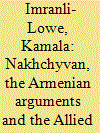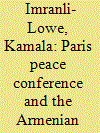| Srl | Item |
| 1 |
ID:
146782


|
|
|
|
|
| Summary/Abstract |
The article explores the territorial conflict between Armenia and Azerbaijan over the Nakhchyvan region after the South Caucasus came under the Allied control following the Mudros Armistice of 30 October 1918. It analyses the arguments of the Armenian Government submitted to the Paris Peace Conference in 1919 to substantiate its vision of territorial delimitation between the two republics with regard to Nakhchyvan, examines the positions of Azerbaijan and Armenia and the Allied Powers on the Nakhchyvan problem and assesses the impact of their stance on the settlement of the issue. It argues that the Armenian claims to the region were land-related, being part of the Armenian nationalist aim of constructing an expanded Armenia from the Mediterranean to Garabagh. It also argues that the Allied Powers were guided by their own interests while making proposals on the settlement of the conflict.
|
|
|
|
|
|
|
|
|
|
|
|
|
|
|
|
| 2 |
ID:
138251


|
|
|
|
|
| Summary/Abstract |
The South Caucasus, which includes Armenia, Azerbaijan and Georgia, is one of the most challenging regions in the world, owing to its long-lasting and ongoing conflicts. One of these conflicts is between Armenia and Azerbaijan, the current stage of which has continued for 25 years without any prospect of a settlement in the near future. For a better understanding of this conflict it is necessary to go back to 1918 and 1919, which witnessed the emergence of the first Azerbaijan and Armenian Republics. The article examines and assesses the ethnic, historical, economic, geographical and security arguments submitted by the Armenian government to the Paris Peace Conference in 1919 to substantiate its vision of territorial delimitation between Armenia and Azerbaijan regarding Garabagh. The article argues that Armenian nationalism was ethnic nationalism and that the Armenian government constructed politically motivated arguments to substantiate its claims to Garabagh, which were part of its nationalist aim of constructing an Armenian ‘ethno-nation’ in the area from the Mediterranean to Garabagh.
|
|
|
|
|
|
|
|
|
|
|
|
|
|
|
|